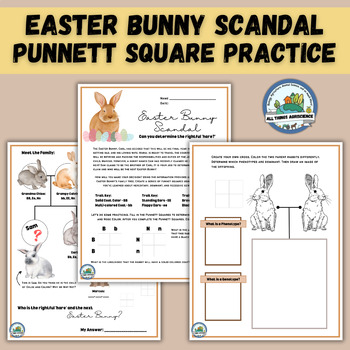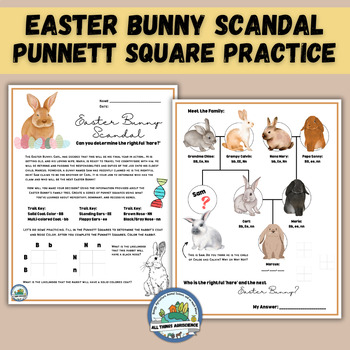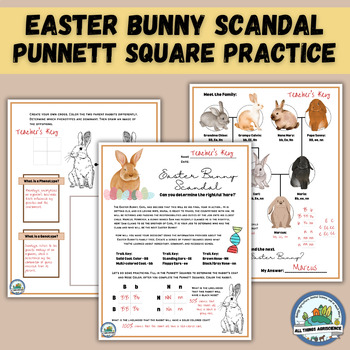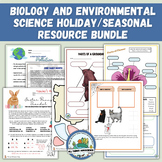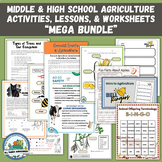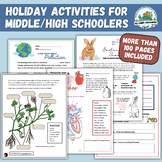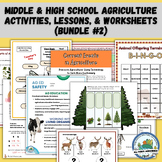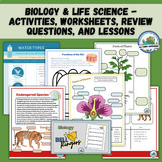Easter Bunny Activity, Heredity & Genetics Practice, Punnett Square Worksheets
- PDF
What educators are saying
Also included in
- Reinforce your students' comprehension of genetics and heredity by including these holiday and seasonal worksheets in your curriculum! Watch as their abilities and confidence using Punnett squares soar to new heights. Middle and high school biology, agricultural, and animal students will thrive as tPrice $11.00Original Price $16.40Save $5.40
- Introducing the ultimate bundle of seasonal/holiday-themed science activities for middle and high school science students! Engage and captivate your biology or environmental students with these fun and relatable resources. Enhance your science curriculum by adding these themed worksheets, activitiesPrice $35.00Original Price $50.00Save $15.00
- These no-prep Easter worksheets, diagrams, and visuals give students a fun and engaging way to learn and practice science-based skills. The resources included in this bundle will help your students understand the anatomy of an "easter" egg and how genetics play a role in determining who the next EasPrice $5.00Original Price $7.00Save $2.00
- This bundle is a conglomeration of resources, including great back-to-school activities, morning work, holiday and seasonal activities, and no prep worksheets - perfect for enhancing your curriculum or leaving as emergency agriculture science sub plans! I used all worksheets, labs, projects, and actPrice $75.00Original Price $106.65Save $31.65
- Introducing the ultimate bundle of holiday-themed, biology and environmental science-focused activities for middle and high school students! Engage and captivate your middle and high school biology, environmental science, or agriculture students with these fun and relatable resources. Each resourcePrice $28.00Original Price $39.75Save $11.75
- If you teach general agriculture, food, plant, animal, or veterinary science and are looking for a few additional no-prep activities to keep students engaged throughout the school year, or if you are looking for the perfect emergency sub plans for any of your Ag Ed courses, this bundle is for you! OPrice $48.00Original Price $66.10Save $18.10
- This bundle contains exceptional resources that are sure to enhance your biology curriculum and bring fun and excitement into your classroom! The multitude of resources included are designed for specifically middle and high school biology students, aligning with NGSS and reinforcing key concepts. StPrice $60.00Original Price $83.95Save $23.95
Description
Gear up for EASTER!! Introducing an engaging and educational resource that brings the mysteries of genetics and heredity to life for your middle and high school science students! Our fun Spring and/or Easter activity is perfect for animal science, biology, and life science classes and will have your students using critical thinking skills and Punnett squares to crack the case of the Easter Bunny's rightful 'hare.'
With a focus on genotypes and phenotypes, this worksheet will challenge your students to analyze a family tree, fill in Punnett squares, and make connections between genetics and physical characteristics. While a basic understanding of dominant and recessive genes is required, this resource also provides practice opportunities and examples to reinforce important concepts.
Not only is this resource engaging and educational, it's also practical for teachers. Leave it for a substitute teacher and rest assured that your students will be kept engaged and determined to solve the scandalous mystery. In fact, many teachers have successfully used this as emergency sub plans in the past with great results.
But don't just take our word for it! Here's what one teacher had to say: "The way this worksheet walks students through solving this scandal makes leaving this for a substitute teacher easy. Even my students who needed help using the punnett squares thought this activity fun and found solving the mystery of the Easter bunny entertaining!"
This resource is not limited to just Easter or Spring - it's a versatile supplement that can be used in a variety of courses, including Intro to Agriculture, AFNR, or biology.
So why wait? Bring the excitement of genetics and heredity to your classroom with our engaging and educational resource, and watch your students develop a deeper understanding of these important scientific concepts while having fun!
If you are interested in another fun way to incorporate genetics and heredity-focused resources into your lessons, click here!
Check out MY TPT STORE for more resources like this, and be sure to leave a product review after using it in your classroom. Your feedback is appreciated and earns you TpT credit for future purchases. Thank you for your support!

